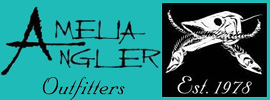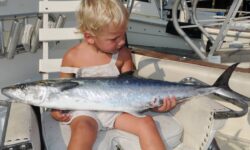For local salt and freshwater fishermen, the fall fishing season is often a favorite time of year while enjoying ideal weather conditions and the best fishing action of the year. Two factors are responsible for the excellent fall fishing action, include major shrimp and mullet migrations teamed with cooling water temperatures that all contribute to unforgettable fall fishing action!
Red drum, frequently called spot tail, or redfish, spawn at both Nassau and Cumberland Sounds where huge schools of a hundred red drum can be found holding in deep passes and close to jetty rocks during the slower moving tides. Many red drum fishermen believe the last few hours of the in-coming tide produces the best action while fishing dead on the bottom with cut baits including ladyfish, whiting, croaker, menhaden, or bluefish. Shrimp mammies caught by local shrimp boats are also premiere red drum bait.
Fall run redfish will often measure well over the maximum Florida State maximum legal size length of twenty-seven inches. Be sure and release oversized red drum properly so they will survive, while leaving the red drum in the water when dislodging the hook. While in some cases, particularly when landed from deep holes, the air bladder of the red drum will inflate and need to be deflated so the red drum will survive. Saltwater fishermen can purchase a special needle that is designed to deflate air bladders from area bait and tackle stores. Simply lay the red drum on its side on a wet towel. Insert the needle just below the dorsal fin and in the middle of the side. The needle should be inserted towards the head as well and at an angle. When the air bladder is punctured properly, you will hear the bladder deflate.
Once the air bladder has been fully deflated, hold the fish in the water until the redfish can swim away in good health. Huge schools of redfish can also be found in the backwaters of Amelia Island during the fall fishing season and are excellent sport when targeted with both spin and fly fishing tackle. Look for some of the best action to come during the full moon, when fall tides flood the spartina marshes. Here redfish will migrate back into the flooded marshes and gorge themselves on their favorite meal, fiddler crabs!
During the falling tide, redfish will migrate from the flooded marshes and school on mud flats where they can be targeted with topwater plugs. Try Rapala’s “Skitter Walk”, Mirror-O-Lures “Top Dog”, or Storm’s “Chug Bug”.
Kingfish can be found at many of the near shore reefs and deep water fish haunts too. One of the best kingfish locations during the fall fishing season, is the “Brunswick Forty Mile Bottom”. Here bluewater fishermen can jig up a livewell full of cigar minnows at the R-5 Navy tower, then begin slow trolling livies close to the tower. Here fishermen will not only find king mackerel, but dolphin, sailfish, barracuda, cobia and many more species of pelagic saltwater game fish.
Fishermen will soon notice that after leaving the Navy Tower and navigating in an easterly direction, the water depth drops from 110 – 125 feet of water within five miles. A rough bottom is soon located which offers excellent trolling and bottom fishing. In fact some of the southeast’s best bottom fishing can be found in these waters while fishing dead on the bottom with fresh squid, or live cigar minnows. Typical species include cobia, grouper, red snapper and black sea bass.
Running further offshore, deep sea fishermen will find the Continental Shelf. Which is located some 7-miles offshore and has a water depth of 180-feet. Trolling with rigged ballyhoo and large plastic lures produces excellent catches of sailfish, wahoo, dolphin, white and blue marlin and black and yellowfin tuna.
One of the more popular styles of fall fishing includes bottom fishing at the many close to shore lime rock live bottoms, rock ledges and wrecks for gag grouper. Bottom fishermen will find numerous fish habitats in water depths of 50-70 feet of water within fifteen miles offshore of the St. Mary’s rock jetties. Anchoring, or drifting over one of these productive fish havens can produce real rod bending grouper action. Deep water catches also include sea bass, triggerfish, amberjack, cobia, vermillion snapper and more. Red snapper are off limits and will need to be properly vented and released. Live baits are extremely productive including Spanish sardines, cigar minnows, finger mullet, or menhaden.
The St. Mary’s jetty rocks are teeming with sheepshead during the last few hours of the falling tide. Fish close to low areas in the jetty rocks with barnacles, or live fiddler crabs. Jetty fishermen are also discovering that cut pieces of blue crab are also extremely productive baits for sheepshead that could weigh over the 10-pound mark.
Flounder fishing peaks at Amelia Island during the Fall fishing season with “Door Mats” weighing to over 10-pounds. One of the very best areas to hook up to the fall run of flounder is the rough bottom running from the Fernandina Port all the way to the footsteps of historical Fort Clinch. Some of the best flounder fishing comes during a falling tide while fishing with live finger mullet, or bullhead minnows slowly along the bottom.
Sea trout fishing peaks as well during the fall fishing season, particularly when a flood tide arrives during mid morning. Working topwater plugs including the “Chug Bug”, “Skitter Walk”, or “Top Dog” close to flooded marshes, at creek mouths, or oysterbars is a both a deadly and exciting fishing tactic for hooking up to Amelia Island sea trout.
Surf fishing is excellent during the fall fishing season while targeting pompano, whiting bluefish, red drum, whiting, puppy drum, small sharks and sea trout. Be sure and sift the surf for “Sand Fleas” that make excellent baits for whiting, red drum, pompano and puppy drum. Cut quarters of live blue crab are considered a delicacy by many surf species. Ultra fresh local shrimp is also premiere bait while fishing in the surf.
I recommend bringing along a 7-foot spinning rod and working a 52 M “Mirror Lure” just behind the breakers for red drum and sea trout. Key areas include the breakers and small jetties located at the southern tip of Amelia Island, the “Pipe Line” located at the lighthouse in the middle of the island and the footsteps of historical Fort Clinch.
Freshwater fishermen are targeting largemouth bass in many of the area freshwater rivers including Lofton, Mills, Thomas’ and Boggy Creeks. Trick worms in the dark color patterns worked close to shoreline covers is a deadly fishing tactic during a falling tide. Trolling, or casting minnow type plugs, or bucktail jigs in the St. Mary’s River between the “Brickyard” boat ramp and the I-95 bridge is deadly for stripers weighing to 15-pounds. In the Nassau River try targeting stripers from the highway 17 bridge to the I-95 Bridge.
Crabbing is great family fun during the fall fishing season while fishing with a chicken, or fish part. Tie a 4-ounce pyramid sinker to the bait and fish the bait dead on the bottom. When a slight tug is detected, pull the crab slowly to the surface and net with a long handled net. Keep the crabs alive in a bucket of water until time for cooking. Bring a large pot of water to bowl with crab seasoning added and place the live crabs in the pot. Boil the crabs until they turn a bright pink and enjoy!
Non-Florida residents will need a saltwater fishing license when fishing from a boat, (charter boats excluded), pier, bridge, or from land. Non Florida residents will also need a fishing license when crabbing as well. Florida residents over the age of sixteen will need a saltwater fishing license when fishing from a boat. Children sixteen and under are exempt.
For more fishing and charter boat information, call the Amelia Angler Outfitters at (904) 261- 2870. Or stop by our store located at 111 Centre St in the Historic district of Fernandina Beach.









